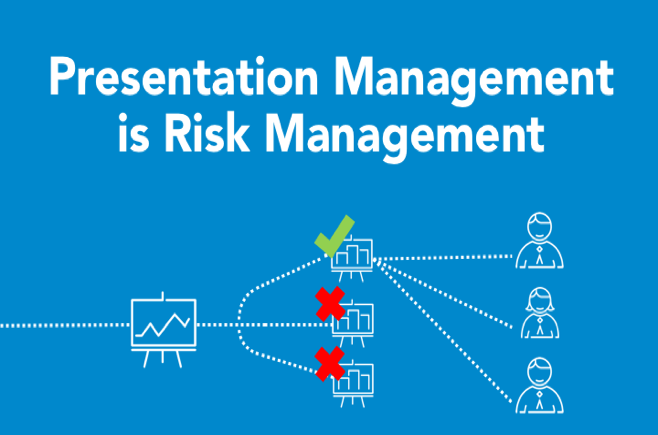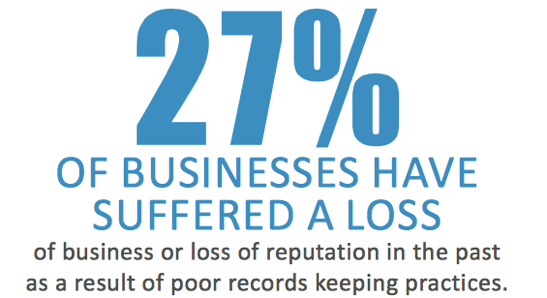Presentation Management is Risk Management
According to Harvard Business Review, between 70% and 80% of a large enterprise’s market value can come from its intangible assets: brand equity, intellectual capital and goodwill.
While the number is certainly nowhere near as big for smaller companies, it’s still an important idea to keep in mind. Poor presentations, for example, reflect poorly on an organization. Great presentations, on the other hand, paint companies in brighter colors. To paraphrase billionaire Warren Buffett, while it may take decades to build up your brand’s reputation, it only takes a few minutes to destroy it.

When company communications go spectacularly bad, organizations are forced to invest a ton of time, money and other resources in rapid response teams, crisis management, PR, recalls and more. Not only can miscommunication take a big bite out of your bottom line, it can also shrink your customer base — giving your competitors an edge.
In this light, presentation management plays an enormous role in mitigating risks that have the potential to drag your company down. The better control you have over your digital assets, the less likely your company will be to make a mistake that damages your name.
Weak Internal Coordination Damages Reputations
According to Harvard Business Review, weak internal coordination is one of the main determinants of reputational risk.
A Framework for Managing Reputational Risk
Understanding the factors that determine reputational risk enables a company to take actions to address them.

To illustrate, imagine a SaaS salesperson is on the other side of the country trying to land a new account. Unfortunately, the sales deck that individual has been given contains several glaring errors that no one in the organization detected before they left on their trip.
During the initial presentation, the salesperson ends up relaying erroneous information about product features and pricing—despite the fact that peers back at headquarters realized the errors were in the deck prior to the presentation. Unfortunately, that fact is never relayed to the salesperson.
The customer likes what they hear during the presentation and agrees to sign on—only to find out later on that a serious mistake has been made. Not only is the salesperson ultimately unable to land the new account, employees there start telling the people in their own networks about the less-than-optimal experience. All of a sudden, the company’s reputation is tarnished over an easily preventable mistake—making it more difficult to land other new clients, too.
In this hypothetical scenario, the weak internal coordination problem manifests itself because the salesperson is unaware they are presenting inaccurate information; whoever created the decks in the first place didn’t do their due diligence and the other team member who discovered the errors didn’t relay them to the salesperson on time.
According to AIIM’s Records Management Strategies survey, 27% of businesses have suffered a loss of business or reputation as a result of poor management practices – despite how easy it is to avoid these kinds of mistakes.

AIIM: Records Management Strategies
Does any of this sound slightly familiar?
With a comprehensive presentation management strategy in place, you get the peace of mind that comes with knowing you’re much less likely to run into these kinds of mishaps.
How presentation management mitigates risk
Thanks to modern technology, it’s now much easier for companies to increase the chances everyone at the organization stays on message every day—thereby avoiding situations like the one described above.
The last thing your company needs is for someone to go off-message in a harmful way—especially when they don’t even mean to. At best, potential customers will think twice about doing business with you once they fact check your claims and research your company further. At worst, your organization could unknowingly violate laws or regulations – which could cause you to hemorrhage customers or face severe fines.
“With the right solution in place, your organization benefits from an insurance policy of sorts that protects you from saying the wrong things or making statements that are altogether illegal.”
The good news is that by investing in a presentation management solution, companies can mitigate these potentially crippling risks and continue growing. That’s because presentation management tools enable organizations to ensure that all of their digital assets are up to date and accessible and that everyone is working off of the same assets – all of the time.
Simply put, presentation management is risk and reputation management. No longer do companies have to worry about a salesperson presenting year-old slides that have since been updated to deliver more compliant messaging.
With the right presentation management tool in place, companies benefit from:
-
Message consistency and brand unification. When different arms of a company are relaying different messages, things can spiral out of control quickly. It’s much harder to fix the damage after the fact than prevent it from happening in the first place. Presentation management enables companies to ensure message consistency and brand unification across the entire organization.
-
Product and service information is accurate and timely. Let’s say a customer is interested in buying a SaaS solution from your company. That person calls one of your offices and hears one thing. Then they call another one of your offices and hear something quite different. The customer is unlikely to consider your organization trustworthy after hearing two employees relay different messages. However, with a robust presentation management system in place, all assets are accessible from a central repository. Everyone leverages the most current ones and stays on the same page—even when they’re proverbially out of the loop.
-
Compliant communications and claims. When your employees send out the wrong messages, it may only be a matter of time before watchdog groups start knocking at your door. Presentation management enables companies to make sure that their messaging is compliant with the law and any pertinent regulations. Taking a proactive approach to digital asset management allows companies to drastically reduce the likelihood they’ll incur fines or other penalties for sharing wrong or non-compliant messages.
-
Critical information is disseminated quickly and efficiently. Imagine one of your best salespeople has been on the road for the last month trying to nab new clients. There’s a problem: You changed your pricing but nobody informed that individual of the changes. So, as the salesperson moves from meeting to meeting, they are relaying outdated information to prospects—which means you’re forced to honor the lower pricing to all the new clients that come on board. The good news is that this scenario is easily avoided with a presentation management system in place. Any changes to relevant data are reflected immediately in digital assets that are available to all team members—no matter where they happen to be. This guarantees that your employees will relay the current critical information and never pitch off the wrong decks.
-
Comprehensive reporting analytics. Not only does storing unnecessary digital assets clog your repositories, it can also be quite expensive depending on how much data you have under your control. Since presentation management solutions enable companies to see which users are accessing which assets and when, it allows them to get rid of duplicate and out-of-date assets to make it easier for employees to find what they’re looking for. It also lets management know which assets are most useful—which helps them know with certainty which slides and files their teams should present in order to achieve the best business outcomes.
Without a presentation management strategy, companies are more likely to spread messages that are misleading, inaccurate, out of date or possibly deceptive. On the other hand, with the right solution in place, your organization benefits from an insurance policy of sorts that protects you from saying the wrong things—or making statements that are altogether false.
There’s no sense in rolling the dice and risking employees presenting different ideas and messages. By investing in a presentation management system, you can rest comfortably knowing that every member of your team is aware of the precise message your organization wants to share.
Not only does this enable you to avoid upset customers and fines, it also helps you convince your clients that your brand cares deeply about the details. That’s the ticket to increasing the lifetime value of all of your customers and keeping them happy and informed.

